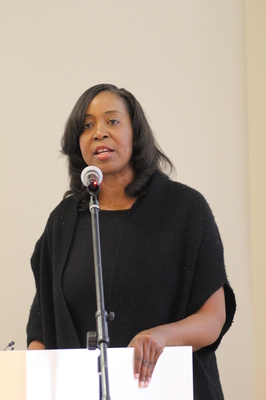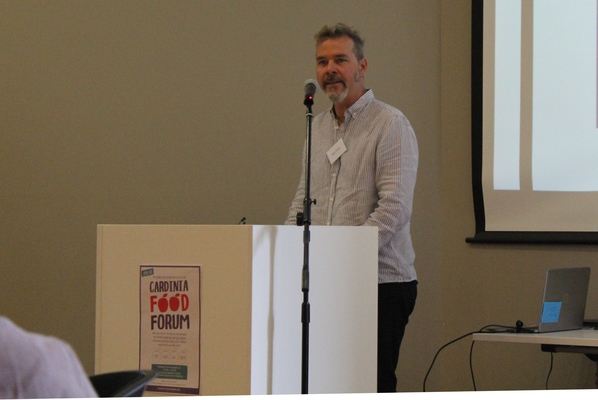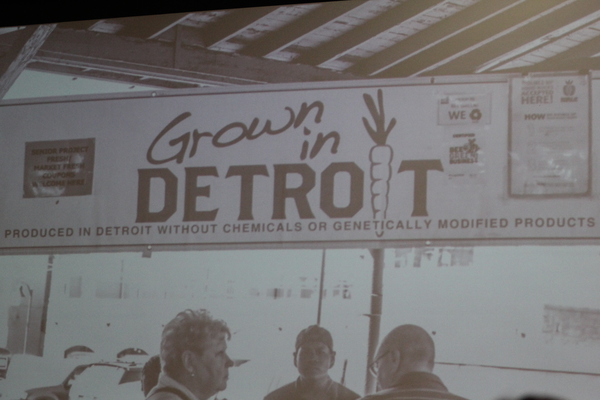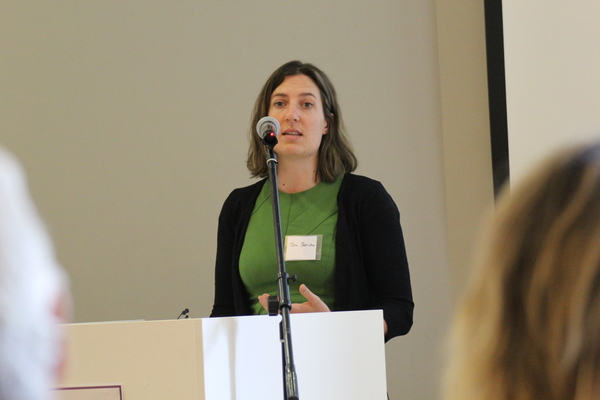
“I wanted to tell the story of how Detroit Michigan, and the people of Detroit Michigan, had been able to transform their food system. That’s the story I want to tell – of the people who believe ‘be the change that you want to see’.” – Devita Davison
A local food revolution is rising up to impact the local region and just how its people view what they eat, as RUSSELL BENNETT discovered.
Last week at Outlook on Toomuc Valley Road in Pakenham, the 2017 Cardinia Food Forum was held to focus on healthy and sustainable food systems for one of the fastest growing regions in Australia.
So much food is produced within the shire but then transported into Melbourne, processed, and brought back out to the south-east for sale.
The Cardinia Food Movement is hoping to change just that.
Nick Rose, the executive director of Sustain: The Australian Food Network, opened the forum by explaining just why its stakeholders – from all walks of life throughout the community – were gathered together.
“Sustain: The Australian Food Network works with people and organisations across Melbourne, across Victoria, across Australia and internationally to support and promote the creation and expansion of healthy, sustainable, and fair food systems,” he said.
“That’s why we’re here today – to launch and celebrate the Cardinia Food Circles Project and with that the Cardinia Food Movement.
“We’re here to acknowledge and celebrate that fantastic work that so many people and organisations across this shire have been doing for so many years.
“We’re here to discuss the challenges that Cardinia’s food system is facing, and we’re here to explore opportunities to collaborate and work together to build a flourishing and delicious food system for all of Cardinia’s residents – now and in the future.”
New Cardinia Shire Council Mayor Collin Ross attended the forum to officially launch the Cardinia Food Circles project and to take on-board any feedback from throughout the day.
“Food is a very important issue in council and we’re privileged today to learn and share a little bit more about it,” he said.
“One thing that we have done in Cardinia Shire is that we’ve worked on a food bowl in the south of the shire.
“This forum looks to transform Cardinia Shire’s food system by listening to you and trying to get your feedback on what we can do better in this area.
“Council has partnered with Sustain: The Australian Food Network to support local efforts that build a healthy, sustainable and fair local food system for all our shire residents.
“There is currently approximately 100,000 people living in Cardinia Shire Council and we expect this to grow to an ultimate population of around 180,000 people over the next 20 years.
“We’ve got an average of about five families per day moving into the shire, most of them with young children.
“When all this new housing is developed to accommodate Melbourne’s growing population, councils on Melbourne’s fringe are seeing the loss of the most productive farming land.
“The rapid urbanisation has the potential to compromise the food security of our region.”
Cr Ross also signed the Urban and Regional Food Declaration on behalf of the council.
Nick explained that it is a document developed in 2013 in discussions with people from across Melbourne’s food system.
“Cardinia today, we’re pleased to say, is going to become the eighth local government in Australia – the seventh in Victoria – and the 39th organisation to become a signatory to this document.
“What’s the purpose of the urban and regional food declaration? It was to achieve a vision of a sustainable, healthy and fair food system recognising that integrated action is needed from individuals, communities, businesses, organisations and government.
“The purpose of this declaration is to encourage such action through offering the following: a set of agreed principles, a lexicon of agreed definitions and common language, a generalised framework for policy and legislative changes, a tool for mobilization and advocacy, and associated set of tools for assessment and analysis.”
The shire, along with a range of key stakeholders across the region, have come together to initiate a collective impact initiative, known as the Cardinia Food Circles project.
Tanya Massy from Sustain said, in simple terms, “it, basically, means a structured form of collaboration”.
“We’re working with key partners across the food system to build a shared vision, and agenda, and to support and work alongside each other to achieve that vision,” she said.
“It unites a lot of the work that’s happening on the ground that can be in a bit of a disconnected fashion, and aligns it towards a common vision to maximise the impact with all of us working together.”
Last week’s forum included a range of panel discussions throughout the day which followed presentations from two key speakers – Devita Davison from Detroit Food Lab in Michigan, and Jen Sheridan from Melbourne University and the Victorian Eco-Innovation Lab.
Both gave an incredible insight into local food systems with Devita, in particular, giving a stunning presentation on just how far her hometown has come since the demise of its automotive industry.
The executive director of the Detroit Food Lab, Devita spoke about the impact of her city once being home to over 2 million people but now home to less than 700,000 people.
It had become a city that was abandoned, and by more than just its automotive industry – but its food industry, too.
“What’s taken place in Detroit is really a powerful and inspiring grassroots movement to literally rebuild the food system from the ground up – from the vacant lots that characterize Detroit’s urban landscape now, a burgeoning network of more than 1500 community gardens and urban farmers involving more than 30,000 people growing food and supported since 2013 by Devita and her team at Food Lab Detroit,” Nick said.
Since 2013, more than 240 businesses have been mentored and supported by Devita and the Detroit Food Lab and in the last year alone more than $7.5 million in sales were generated from these businesses in a city where over 40 per cent of the population is below the poverty line.
“As Devita says, this is all about equity and about empowerment. It’s about food sovereignty,” Nick said.
“As she puts it ‘nothing about us without us is for us’. I think that’s exactly the spirit that we’re capturing here.”
Through her presentation, Devita hoped to provide some inspiration about her city, which was – in her words – “left for dead”.
“But with the determination, the resilience, the bravado, the confidence and that never-give-up spirit that Americans are known for, Detroit Michigan led this people-powered grassroots movement to transform our local food system,” she said, reciting a quote from one of her mentors and heroes Grace Lee Boggs, who was with her in Detroit until she died at 100-years-old in October 2015.
“It was Grace Lee who said: ‘It is in Detroit that I learned that vacant lots represent the possibilities for cultural revolution’,” Devita said.
“My parents moved in the 1960s before my brother and I were born and found a place in Detroit – a place of opportunity. The reason why is because in the 1950s Detroit was this amazing city that put the world on wheels.”
But decades later the 140-square mile city, big enough to fit Manhattan, Boston, and San Francisco in its footprint, was – in Devita’s words – “the poster child of decay”.
“This much we learned in Detroit – and I say this as a cautionary tale – be very careful if you’re a city, a municipality, a state or a country when you put all your eggs in one basket. Detroit put all its eggs in one basket, and that was the automobile industry,” she said.
When it collapsed it left a city in decay.
“Unfortunately in the city of Detroit, dominant industrial grocery stores – probably about three or four – had control over the entire city,” Devita said in the wake of the city’s initial downfall.
“There were very few locally-owned grocery store businesses. It was all dominated by corporate grocery stores, and they left the city of Detroit as well and what they left was a void.
“When they left the city of Detroit what it did was leave a population of now 678,000 people – primarily African Americans – without a place to shop for healthy, fresh, affordable food.
“When we don’t have fresh, healthy, affordable food in our communities what happens is that the repercussions of that are diet-related diseases.
“I wanted to tell the story of how Detroit Michigan, and the people of Detroit Michigan, had been able to transform their food system. That’s the story I want to tell – of the people who believe “be the change that you want to see”.
“If you all want to see a fresh, healthy, equitable, just, fair, local food system then you have to be a part of that change.
“Detroit Michigan, to me, is a land of opportunity and the reason why it’s a land of opportunity is because it has the amount of vacant land that no other major American city has. About a quarter of the city now is vacant.
“We have an amazing grassroots movement now of community leaders and urban farmers and growers, restauranteurs and entrepreneurs who are hungry to be involved in a movement to create change and, most importantly, we have the need for fresh, healthy food.
“Detroit Michigan and all of the stakeholders involved in this local food movement had to be very clear on a goal – we had to be very clear on a vision. We had to be very clear that we’d agree on one mission.
“We were all shooting for this one north star, and that is that the citizens of Detroit are bound and determined to make this city the most sustainable, food sovereign, food secure city on planet earth.”









